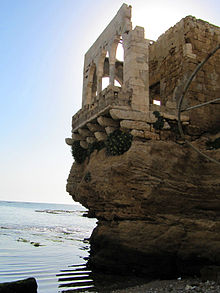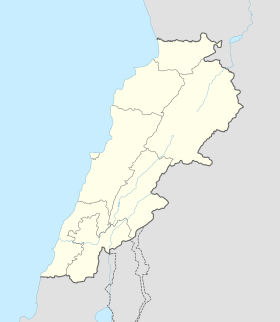Batroun
Batroun
البترون Botrys | |
|---|---|
City | |
 The port at the old city of Batroun with the St. Stephens Church | |
| Coordinates:34°15′0″N35°39′0″E/ 34.25000°N 35.65000°E | |
| Country | |
| Governorate | North Governorate |
| District | Batroun District |
| Government | |
| • Mayor | Marcelino Al Hark |
| Elevation | 34 m (112 ft) |
| Population | |
| • Total | 45,000 |
| Time zone | UTC+2(EET) |
| • Summer (DST) | UTC+3(EEST) |
| Dialing code | +961 (6)Landline |
Batroun(Arabic:ٱلْبَتْرُونal-Batrūn;ChristianandJewish Palestinian Aramaic:בִתרוֹן,romanized:Biṯron,lit. 'the Cleft'), ancientBotrys(Ancient Greek:Βότρυς,romanized:Bótrys),[1][2]is a coastal city innorthern Lebanonand one of theoldest continuously inhabited cities in the world.It is the capital city ofBatroun District.
Etymology[edit]
Batrounappears inWestern Aramaic,[3]and is attested in asbṯrwn(Arabic:بثرون) in premodern Arabic texts, with the expectedlenition of tfor an Aramaic term.[4]Elie Mardini suggests the shift of the th to t inAramaicterms in the Levant is due to the merger of certain fricatives inLevantine Arabic.[5]
History[edit]
Batroun is likely the "Batruna" mentioned in theAmarna letters(EA 078, EA 079, EA 081, EA 087, EA 088, EA 090, EA 093, EA 095, EA 124, EA 129), dating to the 14th century B.C.[1]Batroun was mentioned by the ancient geographersStrabo,[6]Pliny,[7]Ptolemy,Stephanus of Byzantium,[8]andHierocles.Theophanes the Confessorcalled the city "Bostrys."[9]
ThePhoeniciansfounded Batroun on the southern side of the promontory called inclassical antiquityTheoprosoponand during theByzantine Empire,Cape Lithoprosopon. Batroun is said to have been founded byIthobaal I(Ethbaal), king ofTyre(whose daughterJezabelmarriedAhab).[10][2]

The city was under Roman rule toPhoenice Province,and later after the region was Christianized became asuffraganof thePatriarch of Antioch.
In 551, Batroun was destroyed byan earthquake,which also caused mudslides and made the CapeLithoprosoponcrack.[12]Historians believe that Batroun's largenatural harborwas formed during the earthquake.[13]
ThreeGreek Orthodoxbishops are known to have come from Batroun: Porphyrius in 451,Eliasabout 512 and Stephen in 553 (Lequien,II, 827). According to a GreekNotitia episcopatuum,theGreek OrthodoxSee has existed in Batroun since the tenth century when the city was then calledPetrounion.After the Muslim conquests of the region, the name was Arabicized to Batroun.
Batroun was controlled by theCrusadersin 1104,[14]to be known as theLordship of Botrunas part of theCounty of Tripoli,until it was conquered by theMamluk Sultanatein 1289.[15]One of Batroun's archaeological sites isMseilha Fort,which is constructed on an isolated massive rock with steep sides protruding in the middle of a plain surrounded by mountains.[16]
UnderOttomanrule, Batroun was the centre of akazain themutessariflikof Lebanon and the seat of a Maronite diocese, suffragan to theMaronite Catholic Patriarchate of Antioch.Since 1999, it has been the seat of theMaroniteeparchy.[17]
Economy and urban development[edit]
Historically, the city of Batroun was settled at the interface between the sea and the national road that connectedBeiruttoTripoli.
Lately, the radical shift of the historical functions of the local economic tissue into a leisure service-based economy (nightclubs, bars, restaurants, stores, etc.) has become the unique and only lever of the development of the city.[18]The economic metamorphosis has resulted in the resettlement of housing towards emerging city suburbs (nearby hills: New Batroun, Batroun Hills, Basbina, etc.) consequently to the overvaluation of the real estate market in the city centre. It clearly reveals here the constitution of a business city-centre (dedicated to leisure and business) balanced by the constitution of residential suburbs, where acceleratedurban sprawlhas led to the destruction of natural lands (pinewood and orange groves) and to the fatal rise in land prices.[19]
Tourism[edit]



Batroun is a major tourist destination inNorth Lebanon.The town boasts historicMaroniteandGreek Orthodoxchurches. The town is also a major beach resort with a vibrant nightlife that includes pubs and nightclubs.Citrusgroves surround Batroun, and the town has been famous (from the early 20th century) for its fresh lemonade sold at the cafés and restaurants on its main street. Biking along the Batroun coastline is also a major activity mainly in late summer days.
In 2009, the Batroun International Festival was born. It began hosting leading local and international artists. The festival takes place usually in July and/or August of each year in the old harbor area.
Demography[edit]
The people of Batroun are mainlyMaronite,Melkite,andGreek OrthodoxChristians. Batroun is aRoman Catholic(Latin rite)Titular See.[20][21][22]
Politics[edit]
Elections, municipal and parliamentary, in Batroun have seen increasing interest, namely in the context of local and national struggle for power. The current serving Mayor of Batroun is Marcelino El Harek.
Landmarks[edit]

- The Ancient Sea Wall
- El-Bahsa beach
- Makaad El Mir
- El-Mseilha Fort
- St. Stephan's Cathedral
- Historic Souk
See also[edit]
References[edit]
- ^abKnudtzon, Jørgen Alexander(1915).Die El-Amarna-Tafeln.Vol. 2.Leipzig.p. 1165.
{{cite book}}:CS1 maint: location missing publisher (link) - ^abHill, George Francis(1965).Catalogue of the Greek Coins of Phoenicia.Arnaldo Forni - Editore. p. lix.
- ^"The Comprehensive Aramaic Lexicon".cal.huc.edu.
- ^Pat-El, Naʾama; Stokes, Phillip W (24 August 2022). "The 'Aramaic Substrate' Hypothesis in the Levant Revisited".Journal of Semitic Studies.67(2): 24.doi:10.1093/jss/fgac002.
- ^Pat-El, Naʾama; Stokes, Phillip W (24 August 2022). "The 'Aramaic Substrate' Hypothesis in the Levant Revisited".Journal of Semitic Studies.67(2): 24.doi:10.1093/jss/fgac002.
- ^Strabo,Geographica,16.2.18 (Greek sourceandEnglish translation)
- ^Pliny the Elder,Naturalis Historiae,5.17 (Latin sourceandEnglish translation)
- ^Stephanus of Byzantium,Cum annotationibus L. Holsteinii, A. Berkelii et Th. de Pinedo. Vol. I, cum Guilielmi Dindorfii praefatione, cui insunt lectiones libri Vratislav,Leipzig, 1825,p. 117
- ^Malalas, Chronogr., XVIII, in P.G., XCVII, 543, cited inBothrys-Catholic Encyclopediaarticle
- ^(Menander,inJosephus,Antiquities of the Jews,VIII, xiii, 2), cited inBothrys-Catholic Encyclopediaarticle
- ^Hill, George Francis(1965).Catalogue of the Greek Coins of Phoenicia.Arnaldo Forni - Editore. p. lx.
- ^Malalas, Chronogr., XVIII, in P.G., XCVII, 704, cited inBothrys-Catholic Encyclopediaarticle
- ^"The historical earthquakes of Syria: an analysis of large and moderate earthquakes from 1365 B.C. to 1900 A.D."(PDF).Earth-prints.org.Retrieved2012-11-12.
- ^Barber 2012,p. 98.
- ^Runciman 1989,p. 407.
- ^BatrounArchived2010-04-16 at theWayback Machine- Batroun Official Website
- ^"Eparchy of Batrun (Maronite)".Catholic-Hierarchy.org.David M. Cheney.Retrieved23 January2015.
- ^Sfeir, Nagi (August 2018)."Local economic development via urbanism lever: the case of Lebanon"(PDF).SAUES Journal.1(2): 62–78.doi:10.22034/saues.2018.02.01.Archived fromthe original(PDF)on 2019-05-02.Retrieved2019-05-02.
- ^Sfeir, Nagi (2013)."Realurbanism: or the Urban Realpolitik. Towards a" Spatialisation "of the Realist Paradigm from International Relations Theories »"(PDF).Journal of Settlements and Spatial Planning.4(1): 1–10.
- ^"Catholic Encyclopedia: Bothrys".Newadvent.org.Retrieved2012-11-12.
- ^"Botrys".Catholic-Hierarchy.org.David M. Cheney.Retrieved23 January2015.
- ^David M. Cheney (2012-10-24)."Its Bishops and Dioceses, Current and Past".Catholic-Hierarchy.Retrieved2012-11-12.
- Citations
- Barber, Malcolm (2012).The Crusader States.Yale University Press.ISBN978-0-300-11312-9.
- Runciman, Steven(1989).A History of the Crusades, Volume III: The Kingdom of Acre and the Later Crusades.Cambridge University Press.ISBN0-521-06163-6.
External links[edit]
- Batroun District
- Coloniae (Roman)
- Mediterranean port cities and towns in Lebanon
- Populated coastal places in Lebanon
- Populated places in the North Governorate
- Phoenician cities
- Phoenician sites in Lebanon
- Hellenistic colonies
- Crusader churches
- Tourist attractions in Lebanon
- Tourism in Lebanon
- Christian cities in Lebanon
- Maronite Christian communities in Lebanon


